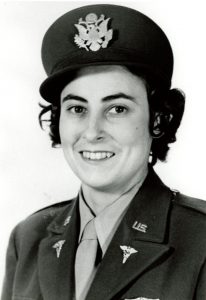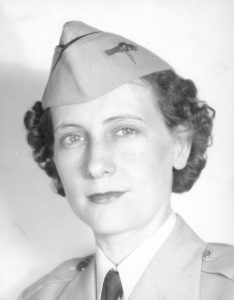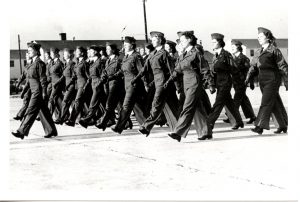In Memoriam
World War II Army Flight Nurses
Jenevieve (Jenny) Boyle Silk, who died in June 2017, was the last living of the 25 World War II US Army flight nurses whom I interviewed in 1986 for what became Beyond the Call of Duty: Army Flight Nursing in World War II. I clearly remember each of my interviews with these remarkable women and still can picture them and hear their voices when I think of them.
Twenty of these interviews are now digitized and available as audio recordings on the Imperial War Museum website. Access the interviews here:
My short remembrances are in the order in which I interviewed these former flight nurses.
Adele Edmonds Daly (1914–2005)
891 MAES, Pacific
Adele Daly née EDMONDS (University of Minnesota School of Nursing, Minneapolis, 1935) worked as a staff nurse at the University of Michigan hospital, then traveled to California, where she worked first at Stanford University Hospital in San Francisco, then in Palo Alto as a hospital and later a clinic nurse. When all the physicians in that practice went into the military after the war began, Adele decided that she would, too. Her brother-in-law was a pilot, and Adele felt under some pressure to serve in the armed forces. She joined in September 1942. Adele heard about flight nursing during her first assignment, at Hamilton Field, CA, and in just under a year, she was on her way to Bowman Field, KY for flight nurse training. She earned her wings on 26 November 1943 with Lee Holtz, Helena Tynan and Lucy Wilson as classmates. All four flight nurses were assigned to the 801 MAES and sent to the Pacific to replace the original cadre of 801 MAES nurses who were rotating back to the US.
Adele recalled having little with which to work once she started flying air evac missions. Medical supplies were limited – plenty of morphine, but fewer bandages. What she was exposed to at Bowman in flight nurse training was helpful, Adele said, but she added:
Except that I think that we never realized that we’d have so little to do with. And I feel fortunate that I went to a school of nursing when I did, because we had to improvise. That was one part of our training, was improvising. And it’s something that you have to have experience with, because you didn’t have everything to do with. You know, all this fancy equipment and everything that even in those days they had, you didn’t have it.
And sometimes, little work to do, which came in spurts. “You did a lot of sitting on the ground, too, and that meant patience,” Adele said. “Many things affected your takeoff – the weather, for instance. … The people in control of the flights decided that you couldn’t leave – why, as I say, there was a lot of sitting on the ground waiting to take off.”
What Adele remembered most was that she often was alone – in flight with no medical technician to assist her, on the ground for layovers when she was the only woman on site. These were her worst experiences during the war. Once when working a flight alone, a psychiatric patient got loose from his litter and grabbed Adele at the neck. But just at that moment the crew chief came out of the cockpit into the cabin, she said, and helped her subdue the patient. “Crew chiefs played a big role in patient care, really.”
Adele recalled one layover when the plane in which she was deadheading with no patients on board had to remain overnight on an island, and the site lacked facilities to accommodate a woman. She wanted to sleep on the plane, but that was against regulations, and they wouldn’t let her sleep where the men would sleep. They found a place for her in a tin equipment shed with a cot. Adele continues the story: “And I wouldn’t sleep in there unless somebody slept with me. So it ended up it was the pilot. … But it turned out real funny. They made a big joke of it, and of course they razzed the pilot unmercifully. … I imagine he made a big story about it, and that was fine.”
But this was an unscheduled layover. For the most part, Adele said, the flight nurses always were considered a part of the team, with the pilots and the crew. “And they always made sure, I think, that you had a place to go, that usually there were some medical people. And they had made arrangements for you to stay someplace. But they were very good about that.” But even scheduled layovers had their challenges: “Bougainville, oooh! That was a place we often remained overnight, and they had a place for us to stay. But there they had so many crawly things! Lizards and snakes. I don’t know how you can prepare yourself for something like that, because I’d always been terrified of them.”
When asked if there was anything she might like to have been different about her time as a flight nurse in World War II, Adele replied that she would have liked to be better prepared in psychiatric nursing. Perhaps recalling her close call when the crew chief came to her rescue, she added that the more nurses knows about psychiatry, the better they can deal with people in such a traumatic situation. It’s helpful to know, she said, “if nothing else, for your own self.” Adele died in 2005 at age 91.
To listen to my interview with Adele Daly, click on the link:
https://www.iwm.org.uk/collections/item/object/80011342
Interviewed 20 June 1986, Palo Alto, CA
Learn more about my interview with Adele on the Blog for 16 Oct 2016.
To be continued



